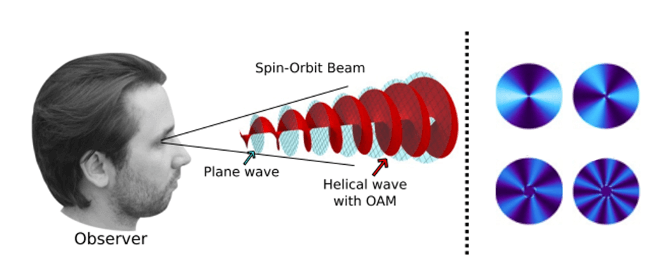Eye diseases such as macular degeneration can have a devastating impact on quality of life. Early detection and treatment are thus crucial for preventing irreversible vision loss. A previous study found that the human eye can detect differences in ‘structured’ light beams. Such light beams are composed of a coherent superposition of differently polarized planar and helical waves. This structured light can be created by coupling polarization and orbital angular momentum to form spin-orbit states with space-varying polarization profiles. The original study determined that a healthy human eye can discriminate between two different spin-orbit states by observing distinct images (i.e., the number of azimuthal fringes) induced by viewing each state. These findings will be expanded to further explore the limits of human perception of structured light. A strong association between an individual’s perception of a structured light beam and the imaging data collected from their eye with the same beam is expected. The possibility of using structured light beams to image ocular structures, including the macular pigment, the cornea, and the retina, will be investigated. Ocular imaging using structured light beams has the potential to detect subtle changes in macular pigment and other ocular structures that occur before macular degeneration progresses to the point of vision loss. Such new sensing tools could enable the early detection and treatment of macular degeneration and reduce the significant societal burden of the disease.

Figure 1. (Left) Representation of a spin-orbit beam composed of a coherent superposition of planar and helical polarized states. (Right) The number of fringes that the eye sees when viewing the spin-orbit beams.
Related Content

Spin Generation and High-Frequency Detection via the Quantum Nonlinear Anomalous Hall Effect in Weyl Semimetals
In magnetic conductors, the passage of current yields an electric field in the transverse direction even without an external magnetic field – this is known as the anomalous Hall effect (AHE). This effect can act as a convenient probe of spin ordering, magnetic textures, spin-orbit coupling, and band topology in solids, and can be further […]
April 19, 2023

Metasurfaces for high-efficiency parametric downconversion and complex quantum state generation
Summary Entangled photon sources are crucial for quantum computing, quantum sensing, and quantum communication. Of growing importance are sources relying on spontaneous parametric downconversion (SPDC). Unfortunately, these sources of entangled photons are often constrained by momentum conservation laws. To overcome this limitation and expand the possibility of quantum state engineering, we intend to use metasurfaces […]
February 1, 2023

Quantum Dynamics of Cavity Interactions with Spin Ensembles
Summary High quality factor cavities can be powerful control elements for ensembles of spins, enabling unitary control as well as on demand cooling. They can also be used to couple two otherwise non-interacting ensembles. The goal of the project is to explore the physics and engineering of such systems both theoretically and experimentally. The laboratory contains a […]
September 7, 2016

Hybrid Quantum Materials towards Topological Quantum Computing
Summary Proximity engineered hybrid materials have shown promise for topological quantum information processing. This form of quantum computing provides a stable, error-tolerant approach for building scalable quantum information processors. Topological quantum computing relies on braiding non-Abelian particles, such as Majorana fermions, which do not exist in nature. One can however use materials engineering to […]
December 8, 2018

